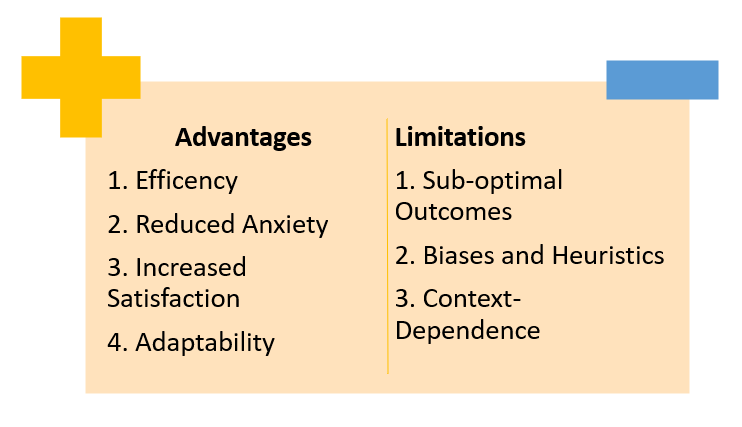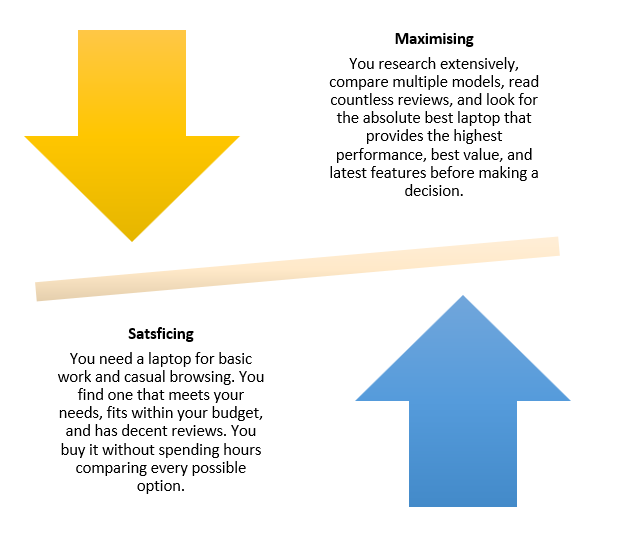In an age of endless options and increasing complexity, decision-making has become a daunting task for individuals in both personal and professional contexts. From choosing a meal at a restaurant to selecting a career path, the overwhelming number of possibilities often leads to stress and indecision. Against this backdrop, the concept of “satisficing” emerges as a pragmatic approach to decision-making. Coined by Nobel laureate Herbert A. Simon in 1956, it refers to a strategy where individuals settle for a solution that meets minimum acceptable criteria rather than pursuing the optimal solution.

The Origins of Satisficing
Herbert Simon introduced the term “satisficing” as part of his broader research on bounded rationality. Bounded rationality challenges the classical notion of humans as fully rational agents capable of analyzing all possible options to make optimal decisions. Instead, Simon argued that cognitive limitations, time constraints, and limited information prevent individuals from achieving perfect rationality.
It is a heuristic—a mental shortcut—that allows individuals to make decisions efficiently by selecting an option that is “good enough” rather than ideal. For example, when purchasing a smartphone, a satisficer might choose the first model that meets their essential requirements, such as battery life, camera quality, and price, without exhaustively comparing every available option.
Simon’s work laid the foundation for modern behavioral economics and psychology, influencing research on decision-making, consumer behavior, and organizational theory (Simon, 1956).
Read More- Mental Health
The Psychology of Satisficing
At its core, satisficing reflects the interplay between human psychology and environmental demands. Several psychological factors underpin the tendency to satisfice-
- Cognitive Load- Decision-making is cognitively demanding, particularly when faced with numerous options. Studies suggest that individuals experience decision fatigue when required to evaluate too many choices, leading to suboptimal outcomes (Baumeister & Tierney, 2011). It reduces cognitive load by simplifying the decision-making process.
- Time Constraints- Time pressure often forces individuals to prioritize efficiency over thoroughness. Research shows that it is more likely when decisions must be made quickly, as it allows individuals to meet deadlines without becoming paralyzed by analysis (Payne et al., 1993).
- Satisficing vs. Maximizing Personality Traits- Psychologists Schwartz et al. (2002) distinguished between “maximizers” and “satisficers” in their decision-making styles. Maximizers strive for the best possible outcome, investing considerable time and effort in exhaustive comparisons. In contrast, satisficers are content with solutions that meet their basic requirements. Interestingly, studies have shown that satisficers often report higher levels of satisfaction and well-being compared to maximizers, who are prone to regret and second-guessing.

Advantages of Satisficing
Some advantages of it include, the following-
- Efficiency- It saves time and mental energy by narrowing the scope of decision-making. Instead of meticulously evaluating every option, satisficers focus on a smaller subset of choices, enabling quicker resolutions.
- Reduced Anxiety- By eliminating the need for perfection, it reduces the stress and anxiety associated with decision-making. This is particularly beneficial in high-stakes situations where the pressure to make the “right” choice can be overwhelming.
- Increased Satisfaction- Counterintuitively, satisficers often experience greater satisfaction with their decisions compared to maximizers. Schwartz et al. (2002) attribute this phenomenon to the “paradox of choice,” where too many options lead to dissatisfaction and regret.
- Adaptability- It fosters adaptability by encouraging individuals to accept imperfection and embrace flexibility. This mindset is particularly valuable in dynamic environments where conditions and priorities may change.
Limitations of Satisficing
Despite its advantages, it is not without drawbacks-
- Suboptimal Outcomes- By definition, it sacrifices optimality for practicality. While this trade-off may be acceptable in low-stakes decisions, it can lead to missed opportunities in situations where achieving the best outcome is critical.
- Bias and Heuristics- Satisficing is influenced by cognitive biases and heuristics, which can distort judgment and lead to poor decisions. For example, the anchoring effect may cause individuals to settle for options that are “good enough” relative to an arbitrary reference point, even if better alternatives exist.
- Context-Dependence- The effectiveness of satisficing depends on the context and the decision-maker’s criteria. In some cases, a satisficing approach may result in decisions that fail to meet minimum standards or align with long-term goals.
Read More- Changing Bad Habits
Applications of Satisficing
Satisficing has wide-ranging applications across various domains:
- Consumer Behavior- In marketing and consumer psychology, it explains why shoppers often select the first product that meets their needs rather than exhaustively comparing alternatives. Retailers can leverage this behavior by ensuring their products meet common criteria and are prominently displayed.
- Workplace Decision-Making- In organizational settings, it is a common strategy for managers facing complex decisions with limited time and resources. For instance, when hiring employees, a manager might choose a candidate who meets essential qualifications rather than searching for the “perfect” fit.
- Public Policy and Governance- Policymakers often use satisficing principles to address societal challenges within resource constraints. For example, they may implement policies that achieve “good enough” outcomes for a majority of stakeholders rather than pursuing ideal but unattainable solutions.
- Healthcare- In healthcare, satisficing can influence both patients and providers. For example, patients may choose treatment options based on availability and convenience rather than efficacy. Similarly, clinicians may opt for “good enough” treatment plans due to time constraints or resource limitations.

Satisficing vs. Optimizing
The tension between satisficing and optimizing continues to be a topic of debate among psychologists, economists, and decision scientists. Proponents of optimizing argue that the pursuit of optimal solutions drives innovation, excellence, and long-term success. In contrast, advocates of satisficing emphasize the practical benefits of efficiency, satisfaction, and adaptability.
One potential resolution lies in a hybrid approach, where individuals satisfice in routine or low-stakes decisions but optimize in high-stakes or transformative situations. This balanced strategy allows for both pragmatism and ambition, depending on the context.
Conclusion
Satisficing represents a practical and psychologically grounded approach to decision-making in a world of increasing complexity. While it may sacrifice optimality, its emphasis on efficiency, satisfaction, and adaptability makes it a valuable tool for navigating everyday challenges. By understanding the principles of satisficing and its applications, individuals and organizations can make more informed choices that balance practicality with long-term goals.
References
Baumeister, R. F., & Tierney, J. (2011). Willpower: Rediscovering the Greatest Human Strength. Penguin Press.
Payne, J. W., Bettman, J. R., & Johnson, E. J. (1993). The Adaptive Decision Maker. Cambridge University Press.
Schwartz, B., Ward, A., Monterosso, J., Lyubomirsky, S., White, K., & Lehman, D. R. (2002). Maximizing versus satisficing: Happiness is a matter of choice. Journal of Personality and Social Psychology, 83(5), 1178–1197.
Simon, H. A. (1956). Rational choice and the structure of the environment. Psychological Review, 63(2), 129–138.
Subscribe to PsychUniverse
Get the latest updates and insights.
Join 2,973 other subscribers!
Niwlikar, B. A. (2025, January 7). Satisficing and Its 4 Important Advantages. PsychUniverse. https://psychuniverse.com/satisficing/




Pingback: Transition from Languishing to Flourishing in 9 Easy Steps - PsychUniverse